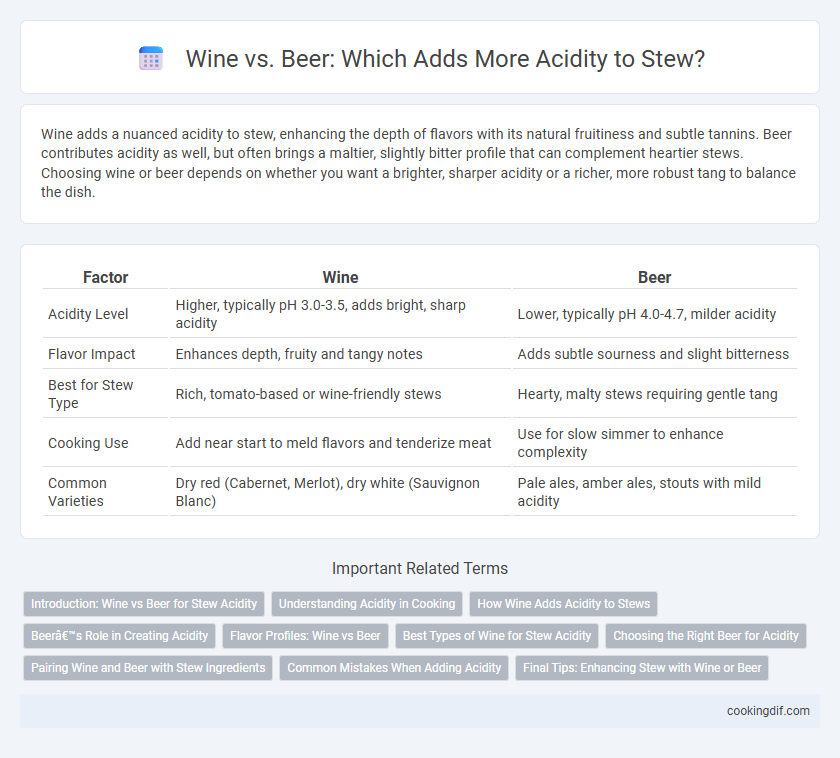Wine adds a nuanced acidity to stew, enhancing the depth of flavors with its natural fruitiness and subtle tannins. Beer contributes acidity as well, but often brings a maltier, slightly bitter profile that can complement heartier stews. Choosing wine or beer depends on whether you want a brighter, sharper acidity or a richer, more robust tang to balance the dish.
Table of Comparison
| Factor | Wine | Beer |
|---|---|---|
| Acidity Level | Higher, typically pH 3.0-3.5, adds bright, sharp acidity | Lower, typically pH 4.0-4.7, milder acidity |
| Flavor Impact | Enhances depth, fruity and tangy notes | Adds subtle sourness and slight bitterness |
| Best for Stew Type | Rich, tomato-based or wine-friendly stews | Hearty, malty stews requiring gentle tang |
| Cooking Use | Add near start to meld flavors and tenderize meat | Use for slow simmer to enhance complexity |
| Common Varieties | Dry red (Cabernet, Merlot), dry white (Sauvignon Blanc) | Pale ales, amber ales, stouts with mild acidity |
Introduction: Wine vs Beer for Stew Acidity
Wine provides a complex acidity that enhances the stew with fruity and tannic notes, which can deepen flavor and balance richness. Beer offers a milder acidity with subtle bitterness, contributing a malty depth and slight carbonation that can lift the stew's profile. Choosing between wine and beer depends on the desired flavor intensity and the stew's ingredients.
Understanding Acidity in Cooking
Wine contains higher levels of tartaric and malic acids compared to beer, making it more effective for introducing bright acidity to stews. Beer offers milder acidity with subtle carbonation that can enhance mouthfeel without overpowering flavors. Recognizing the distinct acid profiles helps cooks balance richness and brightness to achieve the desired stew texture and taste.
How Wine Adds Acidity to Stews
Wine adds acidity to stews through its natural tartness, derived from organic acids like tartaric, malic, and lactic acids, which enhance the overall flavor profile. The acidity in wine helps to break down tougher meat fibers, resulting in a more tender texture and balanced taste. Unlike beer, wine's acidity is more pronounced and integrates seamlessly into slow-cooked dishes, amplifying depth and complexity without overpowering other ingredients.
Beer’s Role in Creating Acidity
Beer contributes a distinct acidity to stews primarily through its fermentation process, which produces organic acids like lactic and acetic acid, enhancing the dish's depth and balance. The malted barley and hops in beer introduce subtle bitter notes alongside acidity, creating a complex flavor profile that complements rich, hearty ingredients. Unlike wine, beer's carbonation can slightly tenderize meat during cooking, adding an extra layer of texture and acidity that brightens the stew.
Flavor Profiles: Wine vs Beer
Wine adds a vibrant acidity with fruity and tannic notes, enhancing a stew's depth and complexity, especially with red varieties like Merlot or Cabernet Sauvignon. Beer contributes a malt-driven acidity with a slightly bitter undertone, creating a richer, earthier flavor profile ideal for hearty stews, particularly with ales or stouts. The choice between wine and beer depends on whether you prefer bright, sharp acidity or a rounded, robust flavor in your stew.
Best Types of Wine for Stew Acidity
Red wine varieties like Cabernet Sauvignon, Merlot, and Zinfandel are excellent choices for adding acidity and depth to stew, enhancing rich flavors with their balanced tannins and fruity notes. Dry white wines such as Sauvignon Blanc and Chardonnay contribute bright acidity and subtle citrus undertones that lighten the stew's intensity. Avoid overly sweet wines, as their high sugar content can interfere with the desired savory balance and acidity in the dish.
Choosing the Right Beer for Acidity
Choosing the right beer to add acidity in stew involves selecting varieties with higher lactic acid content, such as Berliner Weisse or sour ales, which enhance the dish's tanginess without overwhelming other flavors. Beers like pilsners or lagers offer moderate acidity and subtle bitterness, balancing richness while maintaining the stew's depth. Unlike wine, which provides sharper acidity via tartaric and malic acids, beer contributes mild acidity and fermentation complexity, making sour or wheat beers ideal for a nuanced acidic boost.
Pairing Wine and Beer with Stew Ingredients
Red wine with high acidity, such as Cabernet Sauvignon or Merlot, complements rich beef stews by balancing the hearty flavors and tenderizing the meat. Belgian-style beers like Saison or a tart Lambic introduce bright, fruity acidity that enhances vegetable stews with root vegetables like carrots and parsnips. Malty beers like amber ales bring a subtle sweetness that pairs well with stews featuring sweet potatoes or caramelized onions, adding complexity without overwhelming the dish.
Common Mistakes When Adding Acidity
Adding wine instead of beer to stews often results in excessive acidity due to the higher tartaric acid content in wine, leading to a sour and overpowering flavor. Beer, particularly darker varieties like stout or porter, provides a balanced acidity with malt sweetness that complements the meat without overwhelming the palate. Common mistakes include overusing wine for acidity, neglecting the beer's ability to enhance depth and complexity, and failing to adjust other acidic components to maintain flavor harmony.
Final Tips: Enhancing Stew with Wine or Beer
When enhancing stew with acidity, wine offers a sharper, fruit-forward tang that complements rich meats, while beer provides a malty bitterness that balances hearty flavors. Red wine varieties such as Cabernet Sauvignon or Merlot introduce vibrant acidity and tannins, ideal for beef or lamb stews. Dark ales or stouts contribute depth and subtle bitterness, making them excellent choices for robust, savory stews seeking a balanced acidity profile.
Wine vs Beer for adding acidity Infographic

 cookingdif.com
cookingdif.com